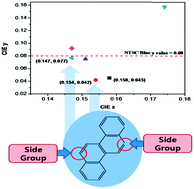Highly efficient emitters of ultra-deep-blue light made from chrysene chromophores†
Abstract
Chrysene, which has a wide band gap, was selected as an emission core to develop and study new materials that emit ultra-deep-blue light with high efficiency. Six compounds introducing various side groups were designed and synthesized: 6,12-bis(3′,5′-diphenylphenyl)chrysene (TP-C-TP), 6-(3′,5′-diphenylphenyl)-12-(3\,5\-diphenylbiphenyl-4′′-yl)chrysene (TP-C-TPB) and 6,12-bis(3′′,5′′-diphenylbiphenyl-4′-yl)chrysene (TPB-C-TPB), which contained bulky aromatic side groups; and N,N,N′,N′-tetraphenyl-chrysene-6,12-diamine (DPA-C-DPA), [12-(4-diphenylamino-phenyl)-chrysen-6-yl]-diphenylamine (DPA-C-TPA) and 6,12-bis[4-(diphenylamino)phenyl]chrysene (TPA-C-TPA), which contained aromatic amine groups, were designed to afford improved hole injection properties. The synthesized materials showed maximum absorption wavelengths at 342–402 nm in the film state and exhibited deep-blue photoluminescence (PL) emissions at 417–464 nm. The use of TP-C-TPB in a non-doped organic light-emitting diode (OLED) device resulted in ultra-deep-blue emission with an external quantum efficiency (EQE) of 4.02% and Commission Internationale de L'Eclairage coordinates (CIE x, y) of (0.154, 0.042) through effective control of the internal conjugation length and suppression of the π–π* stacking. The use of TPA-C-TPA, which includes an aromatic amine side group, afforded an excellent EQE of 4.83% and excellent color coordinates CIE x, y of (0.147, 0.077).

- This article is part of the themed collection: Small Molecules and Monodisperse Oligomers for Organic Electronics

 Please wait while we load your content...
Please wait while we load your content...